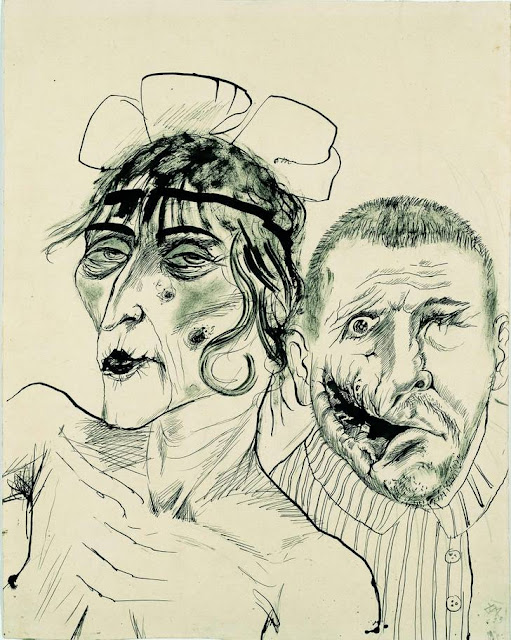 |
| Christian Schad, Selbstbildnis (Self portrait), 1927 |
From Tate Press Release:
Marking 100 years since the end of the
First World War, this exhibition explores the immediate impact of the
conflict on British, German and French art. As the first exhibition to
examine the culture of memorials alongside new developments in post-war
art it will consider how artists responded to the physical and
psychological scars left on Europe. Aftermath brings together
over 150 works from 1916 to 1932 by artists including George Grosz,
Fernand Léger and C.R.W. Nevinson. During this tumultuous period,
artists began to explore new imagery and new ways of making art in their
responses to the experience of war, the culture of remembrance, and the
rebuilding of cities and societies.
The
First World War began to be constructed as memory almost as soon as it
had begun. During the war artists created works which reflected on its
long-term impact. Battlefield landscapes and images of soldiers’s graves
such as William Orpen’s A Grave in a Trench 1917 and Paul Jouve’s Tombe d’un soldat serbe a Kenali 1917 evoked silence and absence in the aftermath of battle.
After
the armistice official public memorials provided a focus for mourning
and remembrance. Artists including Käthe Kollwitz, André Mare and
Charles Sargeant Jagger produced sculptural memorials to commemorate
those who lost their lives in the conflict. The exhibition explores the
different forms that memorials took, and their importance for social and
political cohesion. It also shows the more personal memorials created
using relics of the battlefield such as shrapnel and mortar shells.
Soldiers’ wounds were an alternative memorial, visible in flesh rather than stone, and disabled veterans were a constant reminder of the terrible cost of war. Works such as George Grosz’s Grey Day 1921 and Otto Dix’s Prostitute and Disabled War Veteran 1923
used imagery of disabled veterans to demonstrate the inequalities in
German society. In France, veterans were an important part of the visual
culture of memorial ceremonies. In Britain, images of wounded soldiers
such as Henry Tonks’s medical pastel portraits were usually seen in the
context of therapy and healing.
This
turbulent period also saw the birth of dada and surrealism in the work
of Hannah Höch, Max Ernst, André Masson and Edward Burra among others.
Artists used new visual forms to process experiences and memories of
conflict. Dada photomontages by Hannah Höch reused war imagery while
fragmented bodies and prosthetic limbs featured in works like Grosz and
Heartfield’s The Petit-Bourgeois Philistine Heartfield Gone Wild. Electro-Mechanical Tatlin Sculpture 1920.
As well as the physical and psychological scars left on Europe, the
exhibition also shows how post-war society began to rebuild itself,
inspiring artists such as Georges Braque, Christian Schad and Winifred
Knights to return to classicism and tradition while others such as
Fernand Léger, Paul Citroen and C.R.W. Nevinson turned their minds to
visions of a technological future in the modern city.
Reviews:
Adrian Searle (The Guardian)
Waldemar Januszczak (blog/Sunday Times)
Matthew Collings (Evening Standard)
Alastair Sooke (The Telegraph)
Reviews:
Adrian Searle (The Guardian)
Waldemar Januszczak (blog/Sunday Times)
Matthew Collings (Evening Standard)
Alastair Sooke (The Telegraph)
 |
| Jacob Epstein, Torso in Metal from The Rock Drill, 1913–16 |
 |
| Wilhelm Lehmbruck, Der Gestürzte (The Fallen Man), 1915–16 |
 |
| Winifred Knights, The Deluge, 1920 |
 |
| George Grosz, Grauer Tag (Grey Day), 1921 |
 |
| Käthe Kollwitz, Die Witwe II (TheWidow II), plate 5 from Krieg (War), 1922 |
 |
| Otto Dix, Prostitute and Disabled War Veteran. Two Victims of Capitalism, 1923 |
 |
| Ernst Barlach, Der Schwebende ('The Floating One'), 1927 |
 |
| Meredith Frampton, Marguerite Kelsey, 1928 |
 |
| Curt Querner, Demonstration, 1930 |
 |
| Edward Burra, The Snack Bar, 1930 |
No comments:
Post a Comment